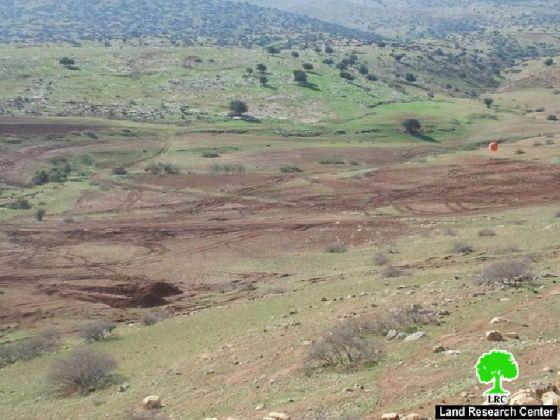Violation: written and verbal eviction notifications for a number of Bedouin communities under the pretext of ‘military training’.
Location: Humsa, al Ras al Ahmar and Ibzeq in the northern Jordan Valley.
Date: April 4, 2013.
Victims: 49 families.
Details:
It has been proven over and over that the Israeli measures against the Palestinians are preplanned and systematic; with the beginning of spring and the mating season for ruminants, the Israeli Occupation Army measures increase rampantly. Since the beginning of 2013, the Israeli Occupation Army conducted a number of military trainings in the Jordan Valley area; the tanks destroyed huge agricultural areas whereas numerous families were deported.
On March 31, 2013, the Israeli Occupation Army ordered 10 Palestinian families residing in Humsa to evacuate their dwellings on April 4, 2013. Furthermore, 49 other families in Humsa, Ibzeq and al Ras al Ahmar received similar orders in the morning of April 4, 2013. The dwellers were notified to evacuate their residences for 8 hours, the duration of the planned skirmishes. Most of the orders were verbal while ten were written.
Picture 2: trails of trainings
Table 1: unfortunate families:
No. |
Location |
Date |
Families |
Residents/ children |
Order |
hours |
1 |
Al Ras al Ahmar |
April 9, 2013
April 23, 2013 |
22 |
117/52 |
8 written, 14 verbal |
06:00 – 14:00 |
2 |
Ibzeq |
April 7, 2013
April 4, 2013
April 10, 2013 |
17 |
132/ 72 |
17 verbal |
05:00 – 14:00 |
3 |
Humsa |
April 9, 2013 |
10 |
70/51 |
8 verbal, 2 written |
18:00-08:00 |
|
|
|
|
|
|
|
Aref Darghma, head of the Al Maleh Villages Council, said: ‘crimes are being committed in the area on daily basis; environment is being damaged and farmers chased away. The farmers are living in communities that are not recognized by the Israelis; communities which the Israelis try to dismantle and evacuate. The Israeli Occupation Authorities assumed control over all the natural resources in the area and used them for colonial expansions. The skirmishes or military training ruin what remained for the Palestinians; the timing is chosen in perfect manner at the beginning of the spring to destroy the agriculture and cut short the mating season for ruminants‘.
The Jordan Valley covers one third of the West Bank total area; after 45 years of occupation; the area was turned into barren lands filled with colonies. 31 Israeli colonies, inhabited by over 7500 colonists exist in the Jordan Valley whereas, there is 18 Palestinian community, inhabited by 56000 Palestinians in the area.
Meanwhile, the Israelis insist that the Jordan Valley is the eastern borders of the Israeli State and consider that non-negotiable. Palestinians are rooted in the Jordan Valley:
70 % of the total area of the Jordan Valley has been classified by the Israelis as ‘military zones’; it is also covered with mine fields.
The biggest loser of the Israeli equation are the Palestinian residents who rely on agriculture as a source of their living.
Despite that, Palestinians in the Jordan Valley, who live in wooden shacks and depend on agriculture and cattle in their living are determined on remaining on these lands and stand in the face of the occupier no matter what it will cost them.














